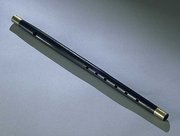Fife (musical instrument)
|
|
A fife is a small, high-pitched, transverse flute often accompanied by drums in a military fife and drum corps. Fifes were commonly used for signaling on the battlefield in the U.S. Army and elsewhere until about the time of the Civil War because they are quite loud. Fifes were one of the most common musical instruments in America's Colonial period, more so than the violin or piano.
A simple instrument typically consisting of a tube with 6 finger holes, an embouchure hole across which the player blows, and a cork or plug inside the tube just above the embouchure hole, the fife is small and very portable. Fifes used in military and marching bands typically are made of wood with metal renforcing bands around the ends to protect them from damage. Fifes used in less strenuous conditions sometimes have a lathe-turned, knob-like decoration at the ends for similar reasons. Some modern fifes are of two-piece construction with a sliding tuning joint similar to some recorders.
Marching fifes typically play in the key of B flat. Fifes in the key of D are also common, and fifes in various other keys are sometimes played in musical ensembles. Fife music is commonly written in the key of D, and played as though the fife played in that key (playing notes D, E, F#, G, A, B and C# as finger holes are uncovered in succession) regardless of what key the fife actually plays in.
An experienced fife player can play 3 full octaves although the fingering patterns necessary for playing in the third octave can be daunting to a beginner. Marching bands typically play only in the second and third octave since these are the loudest and most penetrating. By some reports a military fife can be heard up to 3 miles away over artillery fire.pl:Piszczałka

